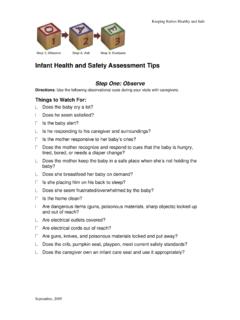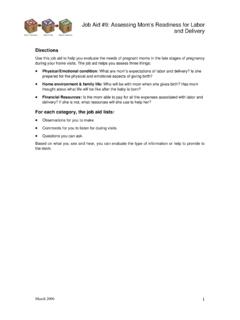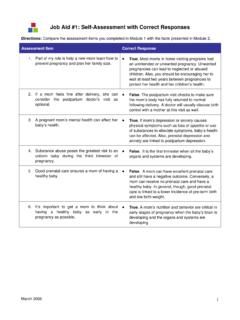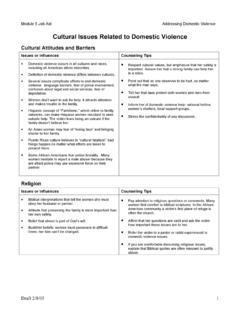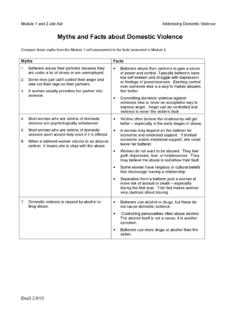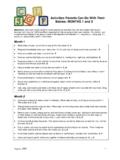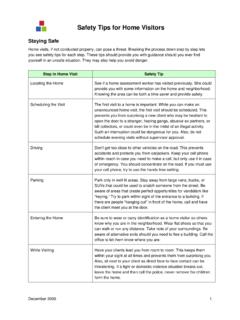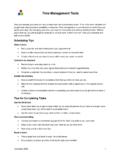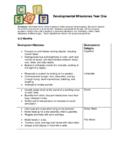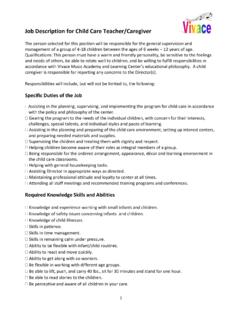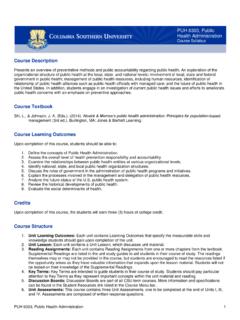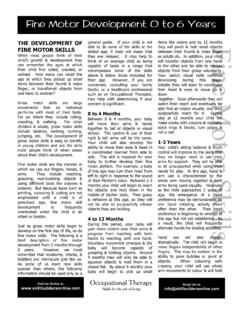Transcription of How Parents Can Keep their Babies Healthy and …
1 September, 2005 How Parents Can keep their Babies Healthy and Safe Directions: Share the following techniques, cues, and strategies with Parents to help them keep their Babies Healthy and safe. Sleeping Use an infant sleep sack or swaddle the baby in a blanket to create a safe yet cozy environment. keep the baby s sleep environment at a cool, controlled temperature. Being too warm or too cold can disturb a baby s sleep. Use movement/motion to lull the baby to sleep. Rocking, swaying and patting will help the baby fall asleep. Use a soothing sshh sound, like the hum of a fan, soft music from a radio or mobile, or a baby soother that imitate sounds from the womb.
2 Establish a bedtime routine. Here is one example: 1. Give the baby a warm bath. 2. Dress the baby in pajamas/nighttime clothes. 3. Sing a lullaby or reading a story or nursery rhyme from a picture book to the baby. 4. Nurse or bottle-feed one last time. 5. Put the baby to bed on her back. Make sure the baby gets adequate daytime rest. Do not keep the baby awake all day so the baby will sleep better at night. If your baby has his days/nights confused, consider limiting the length of daytime naps just a bit Co-sleeping Put Babies to sleep on their backs and not their tummies, unless advised otherwise by a doctor.
3 Don't sleep with your baby if you are under the influence of drugs or alcohol or any substance that could diminish your awareness of your baby. Don't sleep with your baby on soft mattresses and other soft surfaces, such as beanbags, waterbeds and couches. Avoid crevices between mattress and wall or mattress and side rail. Avoid side rails, headboards, and footboards that have slats that could entrap the baby's head. Avoid putting your bed near curtains or blinds that have dangling strings that could strangle a baby. September, 2005 Consider using a side sleeper/co-sleeper attachment device.
4 This device attaches securely and safely right next to an adult bed. This nighttime nurturing device gives both parent and child their own space, but keeps them within touching and nursing range. Preventing SIDS Always place your baby on his/her back to sleep, even for naps. Use a firm mattress in a safety-approved crib. Never leave your baby unattended on a couch or adult bed. Never surround a baby with pillows thinking it will prevent the baby from falling off a couch or bed. Remove soft, fluffy, or loose bedding and stuffed toys from the baby s sleep area. Make sure everyone who cares for your baby knows to place your baby on his/her back to sleep and knows the dangers of soft bedding.
5 Make sure your baby s face and head stay uncovered during sleep. Do not allow smoking around your baby. Don t let your baby get too warm during sleep. keep his/her sleep environment cool and comfortable and do not overdress her. Crying/Comforting When your baby cries, address the baby s basic needs. Consider the following: o Is she hungry? Feed her. o Is she wet or dirty? Change her diaper. o Is she lonely? Pick her up and cuddle her. o Is she gassy? Burp her. o Is she cold? Bundle her up. o Is she hot? Put her in lighter clothing and consider lowering the room temperature. When your baby cries, look for these visual cues to help you understand why he might be crying: o Is your baby opening his mouth and rooting?
6 This could indicate hunger. o Is your baby yawning, rubbing his eyes, moving his head from side to side, or staring out with droopy eyelids? This could mean he s tired. o Does your baby seem to be intentionally looking away from you or starting to hiccup? This could mean she s over stimulated. o Is your baby making facial grimaces and trying to bear down ? This could mean he has intestinal discomfort. If the baby s basic needs have been met and the baby is still crying, focus on soothing your baby by recreating life in the womb . Use Dr. Harvey Karp s Five S s, in this order, to calm your baby: o Swaddle: Wrap your baby in a light blanket so he feels continuously touched and fits tight, just like he was in the womb.
7 Swaddling also keeps the baby s arms from flailing which could upset him even more. September, 2005 o Side/Stomach: Place your baby on her side or on her tummy, while on your lap (not in her crib when you are trying to get her to sleep. Babies should always be put to bed on their backs.) o Sshhhing Sounds: Use soft music, the hum of a fan, the sound of a dryer, a white noise machine, or even a vacuum cleaner to recreate the whooshing sounds the baby heard in the womb. o Swinging: Try rhythmic, monotonous, short, jiggly movements to calm your baby. If you have a baby swing, use the highest setting.
8 Try using a vibrating infant bouncy seat. Use a baby sling/carrier to wear your infant while walking. Take your baby for a walk in the stroller or even take them for a small car ride. o Sucking: Once your baby starts to settle down for the swaddle, side position, shushing, and swinging, he s ready for sucking. Nurse your baby, or offer your baby a pacifier. For more details and exact descriptions/pictures of The Five S s, refer to Dr. Harvey Karp s book, The Happiest Baby On The Block, The New Way To Calm Crying And Help Your Baby Sleep Longer. Use the following description to determine if your baby is colicky.
9 Colicky Babies typically: o Cry three or more hours a day, three days a week, three weeks in a row. o Continue to cry when being comforted, or when their needs have been met. o Often look like they are writhing in pain. o May start and stop their screaming very abruptly. o Have a shrill cry. Preventing Shaken Baby Syndrome Never shake your baby. Always support your baby s head when holding her, burping her, and picking her up or laying her down. Recognize anger and frustration before you want to hit or shake the baby. Take a break. Put your baby in a crib, playpen, or other safe place and leave the room.
10 If the baby s needs have been met, letting her cry while you calm down is fine. Put on soft music to relax. Call a friend, family member, or neighbor (someone you trust) to take the baby so you can relax. Seek professional help to learn coping skills before any damage is done. If you shake your baby, or suspect someone else has, seek medical attention immediately. Never leave your baby with someone you don t trust. Breastfeeding Have a drink of milk, juice, or water just before and during each feeding. Get comfortable. Try lying on your side, sitting up in bed, or using a rocking chair.
